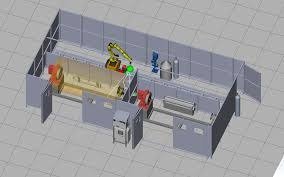“robot operating system: The Powerhouse Behind Modern Robotics”
INTRODUCTION:
The current need for building complex and intelligent robots is a great flexible operating system. The leader in this respect today is the Robot Operating System, or ROS, that is constituted by a comprehensive suite of tools and libraries that make possible sophisticated robotic systems creation.
What is ROS?
ROS is an open-source framework for robot software development based upon a modular approach. The tool, libraries, and the convention set provide infrastructure to build the applications of the robots. The developers can focus on the functional aspects of their robots as much of the low-level activity like navigation, perception, and manipulation need not be re-invented by them.

Major Features of ROS:
Node-Based Architecture: ROS follows a node-based architecture. It essentially comprises nodes which represent an individual component; communication occurs among these nodes by publishing and subscribing via the message system. It has provided flexibility and scalability to design robots.
Standard Message Formats: ROS defines the format of standard messages in many data types including sensor readings, control commands, and image streams. Thus, correct communication among all the diversified robot components is possible.
Tools and Libraries: ROS comes with a very extensive set of toolboxes of tools and libraries for most robotic applications, namely the following.
RViz: A fully functional visualization tool for debugging and monitoring the behavior of robots
Gazebo: a high-fidelity simulator for training and testing algorithms
Navigation Stack: collection of algorithms on localization, mapping, and path planning
Perception Tools: to process sensor Robot Operating System data, like lidar, camera, and sonar.
Manipulation Tools: control robotic arms and grippers.
Community and Support: ROS has a massive and very energetic development community of developers, researchers, and enthusiasts who contribute towards its development and support through forums, tutorials, and internet resources.

Advantages of Using ROS:
Faster Development : Its modular architecture with libraries already written speed up development time and allows prototyping as well as iteration way much faster.
Code Reusability: It prevents the developers from reinventing the wheel by using packages implemented but not used in ROS focuses on those unique features about the robot.
Standardization: It inspires standardization of the community of robotics so it encourages collaboration and knowledge sharing.
Flexibility: ROS applies to a broad spectrum of robots ranging from small research robots to large industrial manipulators.
Open Source: ROS promotes innovation and development of new tools and algorithms because it is open source.
Basic Elements of ROS:
Nodes: Nodes constitute the basic elements of ROS as they are essentially isolated processes meant to achieve a set of defined functions for the robotic system. All nodes can process sensor data, manipulate motors, or decide how to act.
Communication: As ROS follows the pattern of publish-subscribe for message, nodes can listen by publishing information on their topics of interest.
Libraries and Tools: ROS holds many libraries and tools in ease of typical tasks when developing the robotics. Such include computer vision, motion planning, simulation environments etc.
Package Management: The functionality is packaged in ROS. In ROS, the group of related nodes and libraries is known as a package. Such modularity in the software helps the developer share his code and reuse it afterwards.
Simulation: Gazebo is an application, which allows developers to simulate their robots in any environment even before they are exposed to real environments. This is an important capability for testing algorithms and safety.
How ROS Works:
To be able to understand how ROS works, it first becomes crucial to understand its architecture as well as the processes.
1. Node Creation:
The programming languages, for example C++ or Python, form the nodes. A node is established in the robotic system for performing a certain task.
2. Communication Mechanisms:
The nodes, following the publish-subscribe model, communicate through publishing data on the topics. For example, the sensor node publishes data on the topic it is reading over. The other nodes subscribe to the topic to update them.
3. Execution Flow:
It is that period when a robot is ON, then ROS activates all the given setups with active states. These nodes then start acting, according to their established communication methods with other nodes and hence also to start working as one from the robot.
4. Data Handling:
As data is transferred from one node to another, each node analyzes the data relevant to its function. For example, a navigation node will collect data from several sensor nodes to determine its position and move around accordingly.

Applications of ROS:
The versatility of ROS has enabled the application of the platform in the following fields:
Industrial Robotics: Most manufacturing companies employ it to automate production lines besides controlling the arms of the robots.
Agriculture: ROS-based robots assist the farmers to track the crops, and harvest them automatically.
Healthcare: Robots constructed on ROS are used in surgery or rehabilitation in the medical sector.
Universities and research institutes use ROS for prototyping and testing experiments about robotics.
Auto-mobile: The automobile sector uses ROS to create self-driving technology.
Q: What is Robot Operating System?
A: The is an open-source framework through which applications can be built on or within robots. It more represents a tool, sets of libraries, and indeed conventions that will be utilized while developing complex robotic systems. Does this mean I can apply other Q: programming languages in combination with ROS?
A: Yes! While mainly C++ and Python has been the languages widely put to use in the developments of ROS, it even supports other programming languages because of its libraries and interfaces.
Conclusion:
ROS has actually revolutionized the robotics field at its very base. The firm yet flexible foundation it offers to robot operating system build complex applications on top of it makes it a highly sought-after choice in all parts of the globe by researchers and developers alike. Rich in tools, modular in architecture, with great community support, this is surely going to be in the top list of contributions towards this exciting field of robotics.

